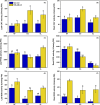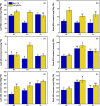Transcriptome analysis unveils the functional effects of ectomycorrhizal fungal colonization on cadmium tolerance of willow saplings
- PMID: 40170923
- PMCID: PMC11958716
- DOI: 10.3389/fmicb.2025.1570200
Transcriptome analysis unveils the functional effects of ectomycorrhizal fungal colonization on cadmium tolerance of willow saplings
Abstract
Introduction: Ectomycorrhizal fungus (ECMF) could enhance plant tolerance to heavy metal toxicity by altering metal accumulation and protecting plants from oxidative injury. However, the molecular mechanisms underlying ECMF-mediated detoxification of cadmium (Cd) in willow sapling are not well known. This study aimed to unveil the roles of Cenococcum geophilum (CG) and Suillus luteus (SL) in regulating Cd toxicity tolerance in willow (Salix psammophila 'Huangpi1') saplings.
Methods: This study systematically evaluated physiological and biochemical parameters in the leaf and root tissues of 18 willow saplings, while concurrently conducting transcriptomic analysis of the roots under Cd stress. The specific treatments were labeled as follows: NF (no ECMF inoculation and no Cd addition), CG (CG colonization only), SL (SL colonization only), NF+Cd (no ECMF inoculation with 100 μM Cd addition), CG+Cd (CG colonization with 100 μM Cd addition), and SL+Cd (SL colonization with 100 μM Cd addition).
Results: The results showed the growth, photosynthesis, antioxidant system and transcriptome of 2-month-old willow saplings responded differently to ECMFs colonization under Cd stress. S. luteus markedly increased the aerial parts biomass, while C. geophilum significantly enhanced the root property indices of willow saplings under Cd stress. The highest number of differentially expressed genes (DEGs) was observed in the comparison between CG+Cd (CG colonization with 100 μM Cd addition) and NF+Cd (no ECMF inoculation with 100 μM Cd addition). C. geophilum colonization activated plant hormone signal transduction and carbohydrate metabolism pathways, while S. luteus enhanced the synthesis of secondary metabolites.
Discussion: This study provides a molecular perspective on the mechanism of interaction between ECMFs and willow saplings under Cd stress and supports the application of ECMFs for phytoremediation of Cd-contaminated soil.
Keywords: antioxidant defense; differentially expressed genes; physiochemical responses; secondary metabolites; willow sapling.
Copyright © 2025 Wang, Yang, Wang, Shi, Dong, Zhao, Qin, He and Wang.
Conflict of interest statement
The authors declare that the research was conducted in the absence of any commercial or financial relationships that could be construed as a potential conflict of interest.
Figures







Similar articles
-
Comparative Physiological and Transcriptome Analysis Provide Insights into the Response of Cenococcum geophilum, an Ectomycorrhizal Fungus to Cadmium Stress.J Fungi (Basel). 2022 Jul 12;8(7):724. doi: 10.3390/jof8070724. J Fungi (Basel). 2022. PMID: 35887479 Free PMC article.
-
Metal-non-tolerant ecotypes of ectomycorrhizal fungi can protect plants from cadmium pollution.Front Plant Sci. 2023 Dec 6;14:1301791. doi: 10.3389/fpls.2023.1301791. eCollection 2023. Front Plant Sci. 2023. PMID: 38126020 Free PMC article.
-
Trichoderma harzianum Rifai 1295-22 mediates growth promotion of crack willow (Salix fragilis) saplings in both clean and metal-contaminated soil.Microb Ecol. 2007 Aug;54(2):306-13. doi: 10.1007/s00248-006-9203-0. Epub 2007 Mar 8. Microb Ecol. 2007. PMID: 17345130
-
Growth, accumulation, and antioxidative responses of two Salix genotypes exposed to cadmium and lead in hydroponic culture.Environ Sci Pollut Res Int. 2019 Jul;26(19):19770-19784. doi: 10.1007/s11356-019-05331-7. Epub 2019 May 14. Environ Sci Pollut Res Int. 2019. PMID: 31090001
-
Arbuscular Mycorrhizal Fungi-Assisted Phytoremediation: A Promising Strategy for Cadmium-Contaminated Soils.Plants (Basel). 2024 Nov 22;13(23):3289. doi: 10.3390/plants13233289. Plants (Basel). 2024. PMID: 39683082 Free PMC article. Review.
References
-
- Balestrini R., Lumini E. (2018). Focus on mycorrhizal symbioses. Appl. Soil Ecol. 123, 299–304. doi: 10.1016/j.apsoil.2017.09.001 - DOI
-
- Baum C., Hrynkiewicz K., Leinweber P., Meißner R. (2006). Heavy-metal mobilization and uptake by mycorrhizal and nonmycorrhizal willows (Salix x dasyclados). J. Plant Nutr. Soil Sci. 169, 516–522. doi: 10.1002/jpln.200521925 - DOI
-
- Cao J., Jiang W., Zhao Y. (2007). Experiment guidance of postharvest physiology and biochemistry of fruits and vegetables. Beijing: China Light Industry Press.
Associated data
LinkOut - more resources
Full Text Sources

